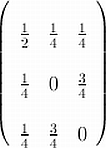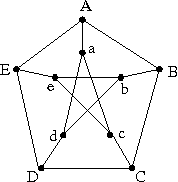Board problem: Write the doubly stochastic matrix

4.4/2b
Our second test is on Monday November 2. You may download the Sample Test 2 to prepare for it.
3.4/1a, 4c; 4.1/2ab, 4a
For 3.4/4c you should use Mike Copley's Java applet to build a heap.
Notes regarding the Java applet:
- The applet does not take negative numbers, so you have to "cheat".
- Then apply the algorithm described in the book and shown in Figure 3.25 to sort the heap. Warning: the procedure in our book to sort the heap is different from what is shown by the applet, so only use the applet to build the heap. Show each stage of the heap while it is being sorted.
- By default the Java applet is blocked. Under Windows, open the Control Panel, search for "java" in the search box, and open the Java control panel. Under the "Security" tab, click "Edit Site List" and add the URL http://www2.hawaii.edu/~janst/demos/s97/mike/HSApplet.html
Bonus Problem: 4.1/8
Bonus question: Express the degree of each vertex in terms of the adjacency matrix, using matrix multiplication. (I told the solution of this one on Wednesday, October 21, 2015, so this one is not open any more.)
Bonus questions:
- Prove or disprove that every triangulation of a polygon can be colored using three colors, even the ones obtained by adding additional vertices.
- Find the chromatic polynomial of a cycle of length n.
Bonus question: The Petersen graph is shown in the picture below.

Bonus question: Prove Grinberg's theorem (Theorem 3 in section 2.2), using Euler's formula.
Bonus question: Work out 1.2/2d in detail, explaining how s(x) is directly related to the degree of the vertex x in some graph, and what this implies regarding the parity of the sum of s(x)
Bonus problem (2pts), expires when this assignment is due: Find the theorem in the book (page number, theorem number) stating the number of edges of a tree.
Bonus question: Prove that the edge graph of the n-dimensional hypercube is bipartite. (The vertices of the n-dimensional hypercube are all binary strings of length n, two vertices are adjacent when exactly one of their coordinates differs.)